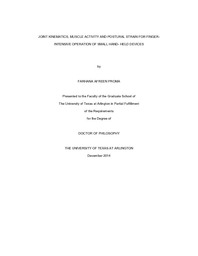
ATTENTION: The works hosted here are being migrated to a new repository that will consolidate resources, improve discoverability, and better show UTA's research impact on the global community. We will update authors as the migration progresses. Please see MavMatrix for more information.
Show simple item record
| dc.contributor.author | Proma, Farhana Afreen | en_US |
| dc.date.accessioned | 2015-07-01T17:50:18Z | |
| dc.date.available | 2015-07-01T17:50:18Z | |
| dc.date.issued | 2014 | |
| dc.date.submitted | January 2014 | en_US |
| dc.identifier.other | DISS-12863 | en_US |
| dc.identifier.uri | http://hdl.handle.net/10106/24905 | |
| dc.description.abstract | Background: Extensive movement of fingers while playing video games, and while browsing or texting in a smartphone often result in medically recognized repetitive strain injuries such as "PlayStation thumb" or "Blackberry thumb". In order to understand the strenuous effects of these tasks, it is important to study the geometry of the movement of fingers (kinematics), corresponding muscle activities (physiology), and the overall posture of the tasks (ergonomics). There is almost no information available in the present literature regarding the finger kinematics of video gaming. Although texting and browsing tasks have been studied, a multifaceted approach including kinematic, physiological and postural information together is not present. In intricate finger-intensive tasks, how the ergonomic posture analysis variables relate to kinematic and physiological variables, is also not known. Methods: Three tasks: playing a videogame (using a sequential and a natural protocol), texting in a smartphone (using index finger of dominant hand, or thumb of dominant hand) and browsing in a smartphone (using index finger of dominant hand, or thumb of dominant hand) were performed by ten subjects in a laboratory setting. Joint angles, velocities and accelerations of the metacarpophalangeal (MCP) and the interphalangeal (IP) joints of the index finger and thumb were calculated. At the same time, the electromyography (EMG) signals were collected from the first dorsal interossei (FDI) and the extensor digitorum (ED) muscles; and later, ergonomic postural risk analyses were conducted using Hand Activity Level (HAL) and Rapid Upper Limb Assessment (RULA) tools. Thus, a total of 49 measures of strain were obtained. Findings: . Video gaming and texting activities resulted in very high velocities and accelerations at the interphalangeal joints of both the fingers; and browsing activities showed very rapid motion at the metacarpophalangeal joint of the thumb. Muscular activity was higher at the ED muscle for all the tasks. Ergonomic task analysis variables, on the average, correlated significantly with 26% of the other variables. Interpretations: The information acquired through this study is novel, and we provided suggestions for better design of game controllers. We also provided suggestions regarding better posture for single-fingered texting and browsing activities on smartphones. Finally, from our results, we concluded that observational ratings of postural strain may not be suitable substitutes for kinematic or EMG measures. | en_US |
| dc.description.sponsorship | Imrhan, Sheik | en_US |
| dc.language.iso | en | en_US |
| dc.publisher | Industrial & Manufacturing Engineering | en_US |
| dc.title | Joint Kinematics, Muscle Activity And Postural Strain For Finger- Intensive Operation Of Small Hand- Held Devices | en_US |
| dc.type | Ph.D. | en_US |
| dc.contributor.committeeChair | Imrhan, Sheik | en_US |
| dc.degree.department | Industrial & Manufacturing Engineering | en_US |
| dc.degree.discipline | Industrial & Manufacturing Engineering | en_US |
| dc.degree.grantor | University of Texas at Arlington | en_US |
| dc.degree.level | doctoral | en_US |
| dc.degree.name | Ph.D. | en_US |
Files in this item
- Name:
- Proma_uta_2502D_12863.pdf
- Size:
- 3.248Mb
- Format:
- PDF
This item appears in the following Collection(s)
Show simple item record


